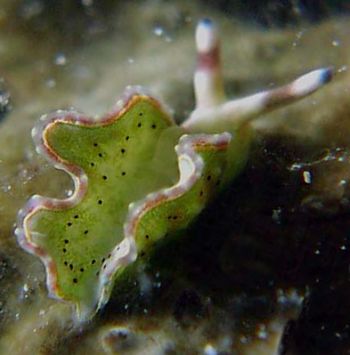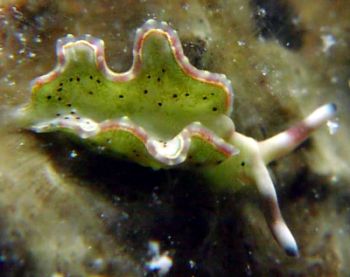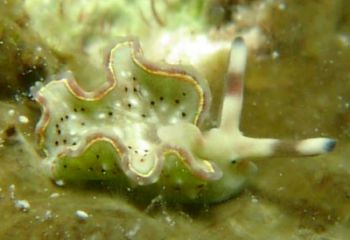
Elysia lobata
Gould, 1852
Order: SACOGLOSSA
Superfamily: ELYSIOIDEA
Family: Elysiidae
DISTRIBUTION
Known from Hawaii, Marshall Ids, Japan (Okinawa, Kerama Ids)
PHOTO
Zamami, Kerama Ids, 10m, off Okinawa, July 13-21,
Length: 10mm. Photo: Jun Imamoto
Reported to be common in Hawaii, where it was originally described in a brief account by Gould: "Animal slug-like, greenish, dotted with black, and bordered with yellow; edge of mantle expanded in to a three lobed lateral wing. Head small with very large and long tentacles, tipped with sky-blue; ...."
The three-lobed parapodia are clearly visible in Gould's illustration. A much fuller description and clearer illustration was published by Ostergaard (1955) where he described it as a new species, E. elsieae, noting the resmblance to E. lobata but suggesting Gould's description was inadequate. Kay (1969) identifies this species with Gould's name and this has apprently been accepted by workers fanmilar with the Hawaiian fauna.
The main characters would appear to be the trilobed parapodia, the lobes gradually diminshing in size from the front ot the back. The rhinophores have a brownish-pink band midway along their length and a bluish tip. The background colour of the body and parapodia ranges from translucent clear to greenish, probably dependent on the stage of the feeding cycle and the parapodia have scattered black and white spots. At the parapodial edge there is a broad translucent pinkish marginal band which has regularly spaced deeper pink patches. At the inside edge of this band is a narrow band of milky yellow, and below this there can be a band of dark green specks. Can grow to 15mm long.
References:
• Gould,AA (1852): Mollusca & Shells. United States Exploring Expedition during the Years 1838-1842. 12: 1-510. [with Atlas of Plates, 1856]
• Kay, E.A. 1979. Hawaiian Marine Shells, Reef and Shore Fauna of Hawaii, 4: Mollusca. Bernice P. Bishop Museum Special Publication 64(4), xviii + 653 pp.
• Suzuki, K. 2000. Opisthobranchs of Izu Peninsula. TBS-BRITANNICA & Co., Ltd., Japan. 178pp.
• Ostergaard, J.M. (1955) Some opisthobranchiate Mollusca from Hawaii. Pacific Science, 9(2): 110-136. (Pls. 1-2)
Rudman, W.B., 2001 (September 2) Elysia lobata Gould, 1852. [In] Sea Slug Forum. Australian Museum, Sydney. Available from http://www.seaslugforum.net/find/elysloba
Related messages
Elysia lobata & E. tokarensis
January 29, 2007
From: Cynthia Trowbridge
Re: message #16343
Dear Bill,
Hi. Last year I asked if anyone knew about who formally synonymized Elysia lobata & E. tokarensis (message #16343, see below). Since this query was deep within a general message about nomenclature, many colleagues may have overlooked my request. Excellent descriptions of E. tokarensis have been given not only by Baba but also by Kitao (1977). I can find no published study on E. lobata radular teeth. Was this synonymy based on taxonomic grounds or just photographic comparisons? Thank you in advance for anyone's assistance.
-
Kitao K (1977) The Sacoglossa from Ishigaki Island (Gastropoda: Opisthobranchia) [in Japanese]. The Nanki Seibutu 19: 64-68.
Cordially,
Cynthia
trowbric@yahoo.com
Trowbridge, C.D., 2007 (Jan 29) Elysia lobata & E. tokarensis. [Message in] Sea Slug Forum. Australian Museum, Sydney. Available from http://www.seaslugforum.net/find/19330Dear Cynthia,
I hope someone can help. Perhaps it was never formally proposed? I ma not sure what the situation is in botany, but no formal case needs to be proposed in zoology -although synonymies are usually presented in the context of an anatomical review. It would become very confusing if old names suddenly began to be used without any mention of later synonyms.
Best wishes,
Bill Rudman
Re: Elysia lobata from Japan
September 9, 2001
From: Jun Imamoto


Dear Bill.
I saw your message about Elysia lobata. As I had previously only sent one photo of this animal I tried to look for another one. While looking through my photos I found a slight difference in colour in different photos of the same individual.
In one photo you can see a pattern of white spots while in the other photo the white spots are not there although the photos are of the same animal.
I was surprised to find such a change of color in such a short time. I think that the observation of sea slugs is very pleasant.
Place: Zamami Kerama Ids, Japan, July 13, 2001. Depth: 10m; Size: about 10mm
Water temperature: 28C degrees.
Best Regards,
Jun Imamoto
imamoto@wips.co.jp
Imamoto, J. , 2001 (Sep 9) Re: Elysia lobata from Japan. [Message in] Sea Slug Forum. Australian Museum, Sydney. Available from http://www.seaslugforum.net/find/5234Dear Jun,
Thanks for these photos. The appearance of the white pustules is quite interesting. I have often suspected that in species of Elysia, such as Elysia ornata, the white pustules which are sometimes present in the parapodia, are either glands, or storage sacs for the white defensive secretions that sacoglossans often exude when disturbed. As I have discussed elswhere on the Forum, these secretions are almost certainly derived from defensive chemicals produced by the plants they feed on.
I thought at first that perhaps the lighting in the photos made the white spots visible in one photo but not the other but in the loswer photo they are clearly visible on both the lighted side of the parapodia and the shaded side. On the outside of the parapodia they appear as quite swollen pustules. My guess is that these are mantle glands, swollen with their white defensive secretions. In the upper photo the glands are empty and so no white region can be seen. If this is correct then the most likely situation is that when you first found the animals the glands were full, but for some reason they emptied the secretions before you took the second photo. Alternatively the opposite could be true. Perhaps the secretions are spread thinly throughout the body wall and only move to the 'glands' or 'sacs' when the animal is disturbed and preparing to discharge the secretions. If that is the case, then your white spotted photo shows an 'irritated' animal about to discharge its nasty secretions.
It would not be that difficult to test. If you find some of these animals, or Elysia ornata, which also sometimes has white spots, take a photo and then gently irritate the animal by touching or poking it with a stick and see what happens. If it has white spots when you start it might secrete a sticky white mucus and lose the spots. If it doesn't have spots when you start it might develop white spots as the secretions aggregate into pustules before being released. Either way it would be an interesting little experiment.
I am glad you are finding the study of these animals so interesting. I must say I am also finding your messages and photos extremely interesting.
Best wishes,
Bill Rudman
Elysia lobata from Japan
September 4, 2001
From: Bill Rudman
Bob Bolland has just changed the identification of an Elysia he had on his website from Elysia rufescens to Elysia lobata. See: http://www.rfbolland.com/okislugs/elysloba.html.
This solves an identification problem I had with a photo sent by Jun Imamoto from Kerama Ids, Japan. Although the angle of the photo does not show the trilobed parapodia, the colour pattern is identical to Bob Bolland's photos. Both Cory Pitman and Terry Gosliner have identified Bob's species as Elysia lobata (Gould, 1852). I have further discussed the identification history of this species at the top of the page.
Best wishes,
Bill Rudman
Elysiidae from Kerama Ids, Japan (2)
August 7, 2001
From: Jun Imamoto

Dear Dr.Rudman,
I went to Atsushi Ono place Zamami, Kerama Ids off Okinawa from July 13-21, 2001.
We were able to observe about 80 kind of sea slugs. Can you identify this species of Elysia please.
Length: 10mm depth: 10M
Water temp:29-30C degree
Best Regards,
Jun Imamoto
imamoto@wips.co.jp
Imamoto, J., 2001 (Aug 7) Elysiidae from Kerama Ids, Japan (2). [Message in] Sea Slug Forum. Australian Museum, Sydney. Available from http://www.seaslugforum.net/find/4937Dear Jun,
I am not sure if this species has been named. Perhaps Kathe Jensen will recognise it for us.
Best Wishes,
Bill Rudman.
